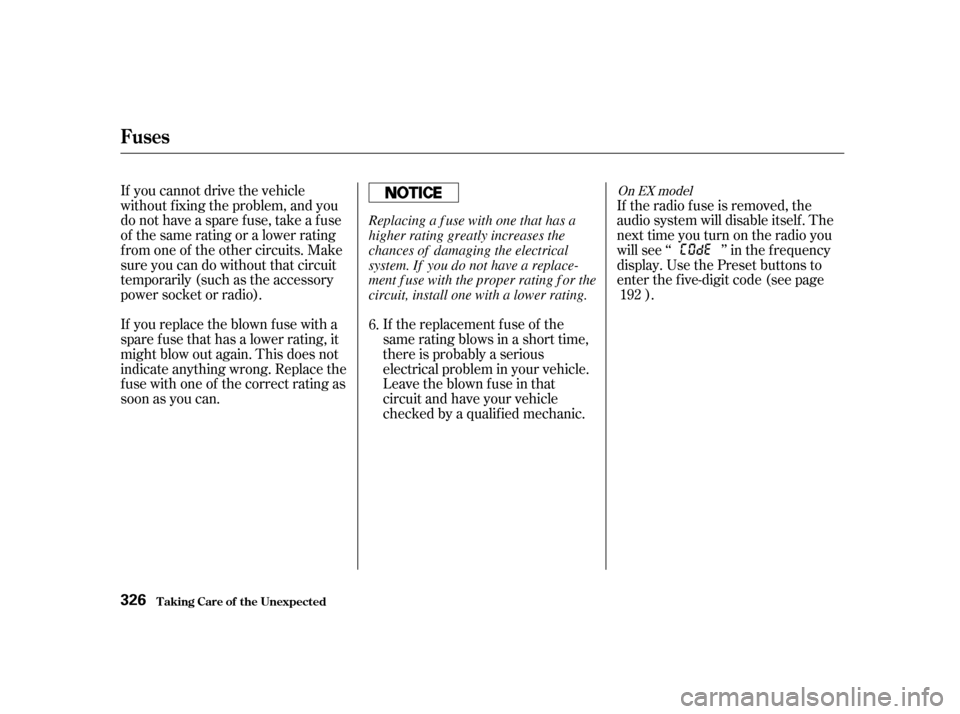Page 300 of 363

This section covers the more-
common problems that motorists
experience with their vehicles. It
gives you inf ormation about how to
safely evaluate the problem and what
to do to correct it. If the problem has
stranded you on the side of the road,
you may be able to get going again.
If not, you will also f ind instructions
on getting your vehicle towed.......................
Compact Spare Tire . 302
....................
Changing a Flat Tire . 303
..........
If Your Engine Won’t Start . 312
Nothing Happens or theStarter Motor Operates ........................
Very Slowly . 312
The Starter Operates ................................
Normally . 313
................................
Jump Starting . 313
............
If Your Engine Overheats . 315
.........
Low Oil Pressure Indicator . 318
..........
Charging System Indicator . 319
.......
Malf unction Indicator Lamp . 320
.......................
Readiness Codes . 321
...............
Brake System Indicator . 322
..............................................
Fuses . 323
..........
Checking and Replacing . 324
......................
Emergency Towing . 329
Taking Care of the Unexpected
T aking Care of t he Unexpect ed 301
Page 311 of 363

Diagnosing why your engine won’t
start f alls into two areas, depending
on what you hear when you turn the
key to START (III):You hear nothing, or almost
nothing. The engine’s starter
motor does not operate at all, or
operates very slowly.
You can hear the starter motor
operating normally, or the starter
motor sounds like it is spinning
f aster than normal, but the engine
does not start up and run. If the headlights dim noticeably or
go out when you try to start the
engine, either the battery is dis-
charged or the connections are
corroded. Check the condition of
the battery and terminal connec-
tions (see page ). You can
then try jump starting the vehicle
f rom a booster battery (see page
).
Check the transmission interlock.
The transmission must be in Park
orNeutralorthestarterwillnot
operate.
Turn the ignition switch to ON (II).
Turn on the headlights and check
their brightness. If the headlights
are very dim or don’t light at all,
the battery is discharged. See
on page .
When you turn the ignition switch to
START (III), you do not hear the
normal noise of the engine trying to
start. You may hear a clicking sound
or series of clicks, or nothing at all.
Check these things: Your vehicle has the Immobilizer
System. You should use a
properly-coded master or valet key
to start the engine (see page ).
A key that is not properly coded
will cause the immobilizer system
indicator in the dash panel to blink
rapidly.
Turn the ignition switch to START
(III). If the headlights do not dim,
check the condition of the f uses. If
thefusesareOK,thereisproba-
bly something wrong with the
electrical circuit f or the ignition
switch or starter motor. You will
need a qualif ied technician to
determine the problem. (See
on page .)
81
313 313267329
Jump Starting
Nothing Happens or the Starter
Motor Operates Very Slowly Emergency T owing
T aking Care of t he Unexpect ed
If Your Engine Won’t Start
312
Page 322 of 363
CONT INUED
All the electrical circuits in your
vehicle have fuses to protect them
f rom a short circuit or overload.
These f uses are located in three f use
boxes.Theinteriorfuseboxesarelocated
underneath the dashboard on each
side.Toopenthefuseboxonthe
passenger’s side, pull the right edge
of the cover.
Fuses
T aking Care of t he Unexpect ed
323
PPAASSSSEENNGGEERR’’SSSSIIDDEEIINNTTEERRIIOORRDDRRIIVVEERR’’SSSSIIDDEEIINNTTEERRIIOORR
Page 323 of 363
If something electrical in your
vehicle stops working, the first thing
youshouldcheckforisablownfuse.
Determine f rom the chart on pagesand , or the diagram on the
f use box lid (the diagram f or the
driver’s side interior f use box is on
the kick panel below the f use box),
which f use or f uses control that
component. Check those f uses f irst,
but check all the f uses bef ore
deciding that a blown f use is not the
cause. Replace any blown f uses and
check the component’s operation.
Turn the ignition switch to LOCK
(0). Make sure the headlights and
all other accessories are of f .
Remove the cover f rom the f use
box.
The secondary f use box is in the
engine compartment next to the
battery.
The primary under-hood f use box is
located in the back of the engine
compartment on the passenger’s side.
To open it, push the tabs as shown.
1.
2. 327 328
Fuses
T aking Care of t he Unexpect ed Checking and Replacing Fuses
324
UUNNDDEERR--HHOOOODDUUNNDDEERR--HHOOOODD
Page 324 of 363
CONT INUED
Look f or a burned wire inside the
f use. If it is burned, replace it with
one of the spare f uses of the same
rating or lower.
Check each of the large f uses in
the primary under-hood f use box
by looking through the top at the
wire inside. Removing these f uses
requires a Phillips-head screw-
driver. Check the smaller f uses in the
under-hood f use box and all the
fuses in the interior fuse boxes by
pulling out each f use with the f use
puller provided in the primary
under-hood f use box.5.
4.
3.
Fuses
T aking Care of t he Unexpect ed 325
FFUUSSEEPPUULLLLEERR
BBLLOOWWNN
BBLLOOWWNN
Page 325 of 363

If you cannot drive the vehicle
without f ixing the problem, and you
do not have a spare fuse, take a fuse
of the same rating or a lower rating
f rom one of the other circuits. Make
sureyoucandowithoutthatcircuit
temporarily (such as the accessory
power socket or radio).
If you replace the blown f use with a
spare f use that has a lower rating, it
might blow out again. This does not
indicate anything wrong. Replace the
f use with one of the correct rating as
soon as you can.If the replacement fuse of the
same rating blows in a short time,
there is probably a serious
electrical problem in your vehicle.
Leave the blown fuse in that
circuit and have your vehicle
checked by a qualif ied mechanic.If the radio f use is removed, the
audio system will disable itself . The
nexttimeyouturnontheradioyou
will see ‘‘ ’’ in the f requency
display. Use the Preset buttons to
enter the f ive-digit code (see page
).
6. 192On EX model
Fuses
T aking Care of t he Unexpect ed
326 Replacing a f use with one that has a
higher rating greatly increases the
chances of damaging the electrical
system. If you do not have a replace-
ment f use with the proper rating f or the
circuit, install one with a lower rating.
Page 326 of 363
�µ�Î
�Î �Î
�Î
�Î
CONT INUED
No. Amps. Circuits Protected No. Amps. Circuits Protected
No. Amps. Circuits Protected 1 23456789
10111213 20 A
30 A
15 A
15 A
15 A
20 A
15 A
20 A
40 A
30 A
30 A
40 A Spare Fuse
Spare Fuse
Right Headlight
ACG S
Hazard
Not Used
Stop
Lef t Headlight
ABS F/S
Power Window Motor
Power Sliding Door
Rear Defroster
Back Up, ACC 1415161718192021222324
40 A
40 A
30 A
7.5 A 10 A
15 A
120 A 30 A
7.5 A 50 A
30 A Power Seat
Heater Motor
Cooling Fan
Spare Fuse
Spare Fuse
Spare Fuse
Battery
Condenser Fan
MG Clutch
Ignition Switch (IG 1 Main)
ABS Motor
12 30 A
40 A Power Sliding Door
Rear A/C :EXmodel
:EXmodel
Fuses
T aking Care of t he Unexpect ed 327
PRIMARY UNDER-HOOD FUSE BOX
SECONDARY UNDER-HOOD FUSE BOX
Page 327 of 363

�Î�Î
�Î �Î
�Î
�Î �Î �Î
On Canadian models
123 4 56789
10111213 15 A
10 A
7.5 A
7.5 A
7.5 A 15 A
10 A
7.5 A 10 A
7.5 A 15 A
30 A
7.5 A Fuel Pump
SRS
Heater Control, A/C Clutch
Relay, Cooling Fan Relay
Power Mirror
Daytime Running Light
ECU(PCM),CruiseControl
Rear Wiper
ACC Relay
Back-up Lights, Instrument
Lights
Turn Signals
IG Coil
Front Wiper
Starter Signal 1 2 345 6 78 9
10 111213141516 20 A
20 A
10 A
20 A
20 A
10 A
7.5 A 20 A
15 A
15 A
15 A
20 A
7.5 A
7.5 A 20 A
7.5 A Driver’s Side Automatic
Sliding Door
Power Seat Reclining
BSC
Power Seat Sliding
Passenger’s Side Automatic
Sliding Door
Daytime Running Light
Left Power Vent
Front Passenger’s Power
Window
ACC Socket
Small Light, License Light
Interior Light, Radio
Power Door Locks
Clock, Back Up
ABS Motor Check
Driver’s Power Window
Right Power Vent
1:2: EX
Canadian models
No. Amps. Circuits Protected No. Amps. Circuits Protected
1
1 1
2
Fuses
T aking Care of t he Unexpect ed
328
Driver’s Side
INTERIOR FUSE BOX
Passenger’s Side
FFrroonnttFFrroonntt
: